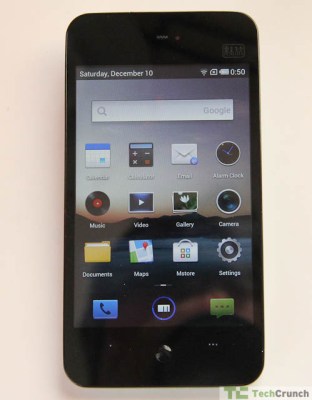The Meizu MX is an odd duck. A Chinese-only smartphone that may (or may not) be reaching our shores, it’s hard not treating it like an oddity washed up on the beach rather than a shipping device. It is a 1.4GHz phone with 1GB of RAM and 16GB of internal storage and has an 8-megapixel camera, Wi-Fi support, and GSM/GPRS/EDGE/CDMA/HSPA+ built-in. It also has a micro SIM slot (which is putting a damper on my testing right now) and micro USB port. It will cost about $450 in Asia when it’s launched January 1st.
That it arrived at my home in a DHL box straight outta Hong Kong, however, suggests that there will be some US availability. This should be pleasing to folks who want a powerhouse Android phone that looks strikingly unlike any of these huge-screened, battery-hogging RAZRs, Galaxies, and LTE devices that are currently littering the phone landscape.
The obvious comparisons are, well, obvious, so I won’t go into them here. In short, this phone looks strikingly similar to another well-known cellphone until you turn it on. The screen is pixel-dense – 960 x 640 of them, to be exact – and beautiful and Meizu has a patented indicator system that changes the two “buttons” below the screen based on phone state. For example, when the left button is supposed to send you back, it turns into an arrow while at the home screen it is a sigle, simple dot.
The phone will get an Ice Cream Sandwich update in the next few weeks (at least according to Meizu) and the current os, a modified Android 2.3.5 called Flyme, is a strange departure from the standard experience. For example, there is no clear “apps” screen and instead apps appear on the “desktop,” much like another phone we all know and love.
In the Darwinian world of Android phones, the Meizu MX is a highly-evolved device that should make Android fans’ mouths water. I’ll take a closer look over the next few days and report back and here’s hoping it hits our shores this year.
